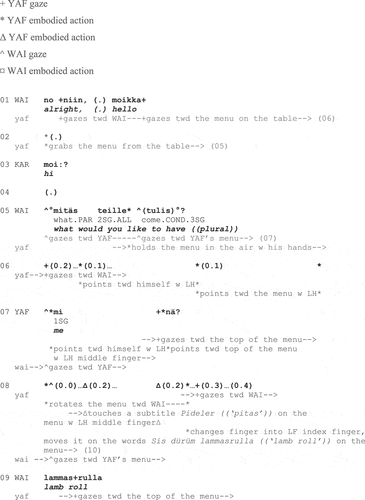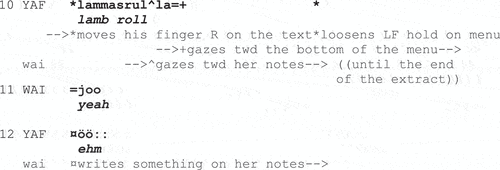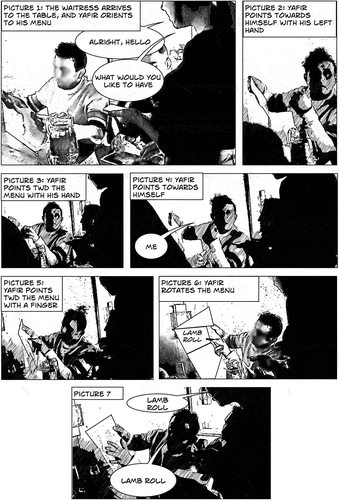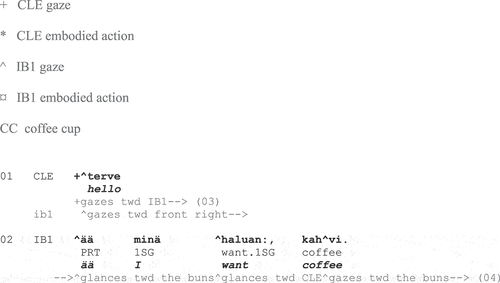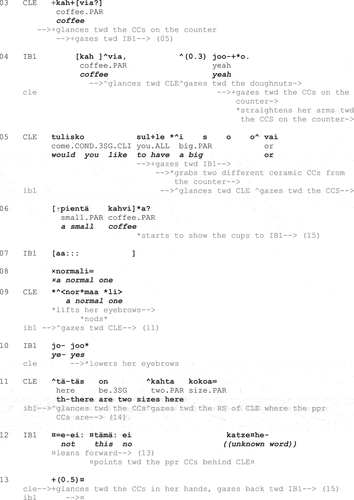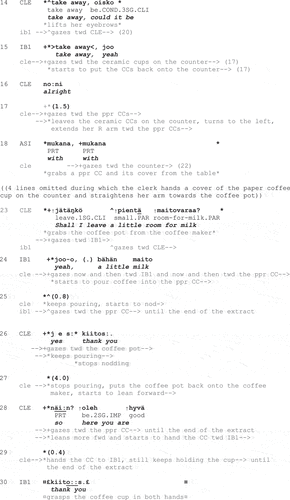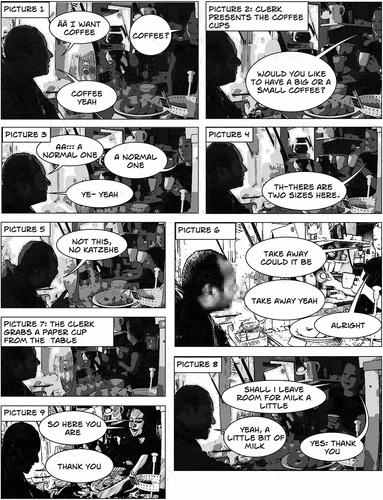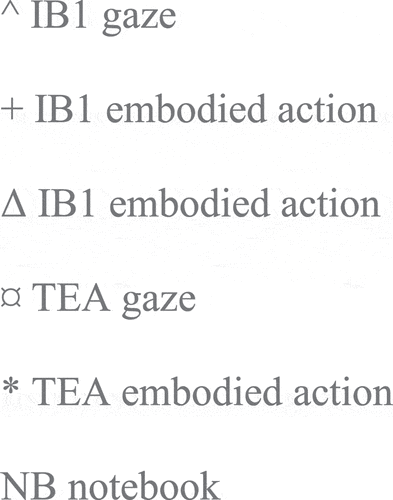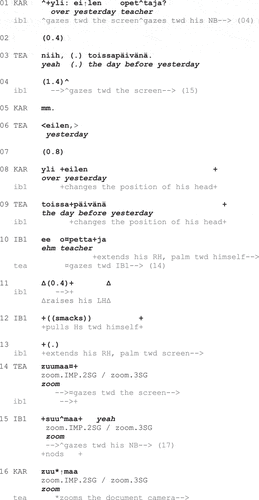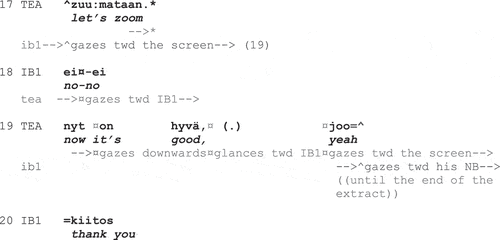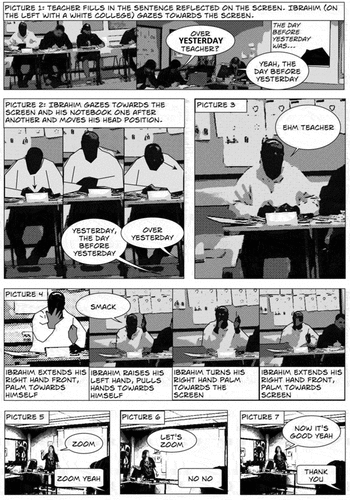ABSTRACT
Adopting the methods of multimodal conversation analysis, this study demonstrates that adult second language (L2) users with emergent literacy formulate requests as ‘complex multimodal Gestalts’ consisting prototypically of deictic or depictive gestures combined with gaze, situationally relevant material, and vocal or linguistic resources. The data obtained for this study are from classroom interactions and out-of-class service encounters that were conducted as part of pedagogical tasks in the context of integration training for adult L2 students with emergent literacy. The analysis shows how co-constructed request sequences typically involve multimodal negotiation in which the co-participants support L2 users to formulate requests that are understandable and that contribute to the progressivity of the interaction. The findings contribute to an understanding of practical requests as multimodal, context-sensitive, collaborative actions and underline the importance of this perspective especially from the view of L2 users with emergent literacy.
1. Introduction
Requests are omnipresent everyday-life social actions. Through requests, people ask others, either directly or indirectly to do something concerning either practical or abstract targets that is beneficial for them (Drew and Couper-Kuhlen Citation2014). People migrating to new countries need to address the challenges of making requests in new languages to be able to conduct their daily affairs in their new home countries.
Requests have been analysed as social actions conducted with not only audible resources, but also with other embodied resources that are interwoven with material ecologies (see an overview Drew and Couper-Kuhlen Citation2014, 16–29; see also Rauniomaa and Keisanen Citation2012; Mondada Citation2014a, Citation2014c; Mondada and Sorjonen Citation2016; Rossi Citation2014, Citation2015; Sorjonen and Raevaara Citation2014.) This paper aims to contribute to this line of research by adopting multimodal conversation analysis as an approach to examine video data gathered from participant groups that have not been extensively researched previously: adult second language users who simultaneously study Finnish language and literacy with the Latin alphabet. The present investigation refers to this participant group as adult L2 users with emergent literacy (see Eilola and Lilja Citation2021).
The analysis demonstrates that adult L2 users with emergent literacy recurrently formulate requests as ‘complex multimodal Gestalts’ (Mondada Citation2014b; i.e. ‘CMG’, Routarinne et al. Citation2020). These prototypically consist of deictic or depictive gestures combined with gaze, situationally relevant materials, and vocal or linguistic resources. The specific focus of this study is on the co-constructed request sequences that typically involve multimodal negotiation with the beginning Finnish language user as the requester and the advanced Finnish speaker as the requestee. The paper also aims to show how in the contexts of classroom interaction and out-of-class service encounters, advanced speakers support L2 users with emergent literacy in designing their requests to assure that they are understandable and that they contribute to the progressivity of the interaction appropriately. In the sequences analysed, participants request either concrete objects or services (see Rauniomaa and Keisanen Citation2012, 830). The findings contribute to an understanding of requests as multimodal, context-sensitive, collaborative actions, and underline the importance of this perspective especially from the view of second language users with emergent literacy.
2. Request sequences from the perspectives of multimodal CA and institutional interactions
Requests are actions that are used to affect another person’s action, and in which the obligation to undertake that action is relatively weak compared to commands (Drew and Couper-Kuhlen Citation2014). A request can target a concrete thing or action, such as a request for a coffee in a service encounter. A request can also concern more abstract entities, such as asking for information. The target of request affects the formulation of the request (Drew and Couper-Kuhlen Citation2014).
2.1. Multimodal request sequences
Objects are elements of our physical environment that we can experience with our senses and that can be examined as resources that ‘are situated within and contribute to developing processes and trajectories of social interaction’. (Nevile et al. Citation2014, 17, emphasis in original). For example, during service encounters at a marketplace, products are typically not only visible but also available to experience with our other senses. As for the classroom, students are not necessarily close to all the relevant shared objects, such as the board. By analysing requests in these two institutional settings and by considering the similarities and differences in them, I demonstrate that our material environment entails embodied interactional work that incorporates deictic or depictive gestures that are crucial to requests.Deictic gestures are hand movements that point to visible or invisible objects and locate them in space and time (Kendon Citation2004, 199–224.) Thus, deictic gestures are always connected to the objects surrounding them. When we use depictive gestures, we ‘produce pictures of the world’ by using our hands to draw, handle, or mime (Streeck Citation2009, 149). These gestures depict concrete objects, actions, or scenes that are usually linked to our talk (Streeck Citation2009). CA research has also highlighted the relevance of both deictic and depictive gestures in relation to the physical world they occur in (see Goodwin Citation2007, Citation2017).
A growing body of research analyses request sequences, in particular the concrete, here-and-now needs by examining the use of different modalities, specifically other than talk, in various situations (Mondada Citation2014a, Citation2014b; Rauniomaa and Keisanen Citation2012; Rossi Citation2014, Citation2015). This research has also demonstrated that it is essential to closely investigate request sequences by taking into account all the modalities and the local environment of the sequences. These studies have also illustrated how linguistic means are used to elaborate otherwise nonvocally produced requests.
Rossi (Citation2014, Citation2015) analyses requests for immediate, practical actions in everyday interactions. He shows how passing an object may implement the action of request (such as cutting a potato) or be a fulfilment of it (when a requester has asked a recipient to transfer an object). Furthermore, requests can be conducted by holding or reaching for an object or through deictic gestures, such as pointing towards the window as an indirect request to open it (see also Mondada Citation2014a, Citation2014c for multimodal requests in surgeries). Rossi (Citation2014, Citation2015) demonstrates that in a few cases, depictive gestures can also be used to act out activities, such as making a hand movement to indicate writing to request someone to sign a form. These actions are highly sensitive to the local environment and highlight the next relevant action that can be achieved with the object in question. This type of request also requires the requestee to somehow manoeuvre the object being requested. In terms of the choice between the modalities, embodied action is principally sufficiently accountable, and it also displays trust towards the recipient. However, speakers can typically verbalise an otherwise nonverbal request when they need to specify the request due to poor projectability of the activity, limitations in visual perceptuality, or to get recipients to pay attention to those speaking to them.
Rauniomaa and Keisanen (Citation2012) have examined daily face-to-face and in-car conversations and analysed ‘requests and responses as action sequences that concern the transfer of an object or service’ (Citation2012, 830). They have concentrated on the responses of these sequences, and have identified two different preferred types, the clear majority being merely fulfilments which are usually conducted with embodied means, and the remaining responses occur in the format of multimodal acceptance and (future) fulfilment. The authors also note that the requested action can be elaborated on with talk in otherwise silently constructed requests. Talk can also serve as a means of receiving a response more rapidly.
The term ‘complex multimodal Gestalt’ (Mondada Citation2014a, Citation2014b) refers to combinations of different resources, such as language and the movements of body parts, that formulate actions progressively, sequentially, temporally, and situatedly in their material and interactional environments. The parts of a ‘CMG’ (see Routarinne et al. Citation2020) together indexically form something greater than its separate parts. This perspective enables a researcher to analyse the (partly) co-occurring use of different multimodal resources comprehensively talking into consideration both the broader context of the action and its occasional details (Mondada Citation2019). In the present paper, the notion of CMG is applied to analyse the interplay of embodied, material, and verbal resources that the participants use (see Routarinne et al. Citation2020).
Some of the request sequences of the present paper resemble those found in the study by Rauniomaa and Keisanen (Citation2012), who report that the proper fulfilment might occur later. Particularly in a restaurant setting, the ordered dish cannot be immediately served because it first needs to be prepared. In the classroom data, the need for the requested object or service is immediate, and the fulfilment is typically also conducted in the here-and-now. The contexts of service encounters and classroom interaction also differ reflexively in terms of participant orientations to the on-going activities: in service encounters, requests are expected, whereas in the classroom, they typically halt the progressivity of an on-going joint action or activity. By analysing situations in which participants have limited shared linguistic resources, the present study attempts to contribute to our understanding of practical requests (i.e. requests for services or concrete objects) as multimodal social actions.
2.2. Request sequences in institutional and second language interactions
In the current study, the request sequences occur in two different institutional settings (classrooms and service encounters) where at least one of the participants is required to conduct their institutional role that includes an assumption to fulfil others’ needs. Even though this analysis does not focus on comparing settings, these two contexts provide an opportunity to broaden our understanding of requests by analysing them in two different environments that make various social actions possible (see Hellermann et al. Citation2019). During service encounters, the essential task is to provide a service, and the participants assume their roles as a salesperson and client with the former aiming to provide a service sought by the latter (Félix-Brasdefer Citation2015.) Moreover, institutional service encounters often involve insert expansions of request sequences, especially pre-seconds, in which the clerks tend to seek further information regarding the requested service (Schegloff Citation2007, 100, 108–109).
Research on Finnish service encounters (Halonen and Koivisto CitationForthcoming; Mondada and Sorjonen Citation2016; Sorjonen and Raevaara Citation2014) has shown that relevant factors in the trajectory of interaction are the physical and interactional environment as well as participants’ mutual gaze and further, that request sequences do not necessarily require verbal action (unless the products have been hidden from customers, such as tobacco products in Finland). The modalities and formats used are connected to indexicality and to what is considered as economic: how obvious the need is without talk in that particular encounter. Nonetheless, talkless cases occur rarely.
In terms of the linguistically asymmetric service encounters, Anglade, Le Dorze, and Croteau (Citation2019, Citation2021) have analysed how service encounters unfold between people with aphasia and salespersons and focused on the action formulation and ascription of request sequences. The findings illustrate how the clerks’ understanding of the requests is usually achieved rapidly, without other-repair, but in some cases the proper requests are also co-constructed (Anglade, Le Dorze, and Croteau Citation2021). The embodied modalities the clients adopt to request the items they wanted to buy were identified to be pointing or representing the desired product (Anglade, Le Dorze, and Croteau Citation2019.) Anglade, Le Dorze, and Croteau’s research (Citation2019, Citation2021) discusses the interwoven factors that support action ascription: besides verbal action, requests are formulated by orienting to the material, interactional, and to the broader contextual environment of the situation, expressed by deictic gestures, body movements, and gazing.
Whereas teachers and students assume institutional roles in the classroom, requests by students break the IRE/IRF structure of classroom discourse, as they are student-initiated actions (see Garton Citation2012). In the present study, the request sequences in the classroom occur relatively spontaneously and thus either interrupt the ongoing plenary activity or may overlap with other co-occurring sequences when activities are more student-centred. Thus, their interactional environments vary.
Most studies on requests in general as well as on requests in the context of second language acquisition (SLA), draw from speech act theory in which a request is examined as a single linguistic utterance or a turn at talk (see Kendrick and Drew Citation2016, 3). However, some exceptions provide detailed accounts on the sequential positions and structures of requests by second language users. The data in these studies have been gathered by prompted tasks (Al-Gahtani and Roever Citation2012, Citation2013) as well as naturally occurring interactions (Al-Gahtani and Roever Citation2014; Eskildsen and Kasper Citation2019; Routarinne and Ahlholm Citation2021), and sometimes both (Roever and Al-Gahtani Citation2015).
In terms of the sequence organisation of requests, the work by Al-Gahtani and Roever is especially relevant to the present study, as it focusses on requests for objects or services in L2 settings (Al-Gahtani and Roever Citation2012, Citation2013, Citation2014; Roever and Al-Gahtani Citation2015). Their research based on audio-recorded data has examined the sequential structure, sequence expansions, and the position of requests by L2 learners at different proficiency levels. These studies show that beginning level language learners use a relatively limited number of explanations and accounts prior to their requests. Instead, the recipients conduct crucial interactional work by launching insert expansions in the form of other-initiated repairs, including clarifications, confirmations, candidate understandings, and even direct offers, whereas they rarely ask beginners further questions that might complicate the situation. The findings indicate that the more advanced the learner is, the more smoothly they launch and maintain request sequences, and the more they adopt a guiding role in them (Al-Gahtani and Roever Citation2012, Citation2013, Citation2014; Roever and Al-Gahtani Citation2015).
From the perspective of language learning as an embodied phenomenon, Routarinne and Ahlholm (Citation2021) provide a longitudinal analysis of requests by a nine-year-old Finnish learner in a multilingual classroom setting. They examine requests as interactional actions that rely on the local environment and embodiment and demonstrate the development of linguistic structures in requests. In a similar recent CA-SLA study, Eskildsen and Kasper (Citation2019) analyse requests in the classroom context longitudinally and concentrate particularly on the focal student’s uses of ‘can’ and its pragmatic functions. They demonstrate that the meanings of expressions are context-sensitive and specifically highlight the interactional and sequential dimensions of second language use and development. Responding to calls for research that would attend to the multimodality of L2 interaction, the present study concentrates on multimodal request sequences by adult L2 users with emergent literacy.
3. Data and method
The data for the present study was collected through eight-month longitudinal video-ethnographic fieldwork with multilingual groups of adult Finnish language and literacy learners who participated in their integration training as newcomers to Finland. The classroom data set comprises approximately 20 hours of video-recorded classroom interaction. The data also include four sets of service encounters from a marketplace, restaurant, café, and a pharmacy including a total of 26 service encounters. These were video-recorded as part of pedagogical interventions conducted in the integration courses for the same newcomers. The interventions aimed at bridging the gaps between participants’ language-use environments in the classroom and beyond. These three-phase interventions involved preparation for service encounters, participating in those interactions and videorecording them, and reflecting on them retrospectively back in the classroom. The service agents were requested to use Finnish in the interactions. Similar types of pedagogical interventions have been described in more detail elsewhere (see Eilola and Lilja Citation2021).
The participants had migrated to Finland as asylum seekers or refugees. Through language and literacy tests, these individuals had been identified as students who needed extra support for their literacy and for learning the Latin alphabet (see Eilola and Lilja Citation2021). However, the participants’ literacy and language proficiency profiles varied. Informed consent to participate in the research project was requested by first getting acquainted with the groups in the classroom and, after a few weeks of regular participant-observation, explaining the objective of the study to the participants using Easy Finnish and interpreters. The participants were told that their participation was voluntary, and all but three students granted their consent for video recordings. The latter three did nonetheless grant their consent to be audio-recorded. Thus, the cameras were placed so that the angles did not capture the participants who had not given their consent for video recording. All the customer service agents involved in the service encounters were informed beforehand about the purpose of the interventions and they all gave their consent to the video recordings.
The analytical orientation adopted for this study is multimodal conversation analysis that takes into consideration the relevant details in the data (Mondada Citation2018, Citation2019). The data extracts have been transcribed according to the multimodal transcription conventions developed by Mondada (Citationn.d.). In addition, the data extracts have been represented as graphic transcripts that are approachable visualisations of the crucial parts of the analyses, but these do not capture the temporality in detail (see Laurier Citation2014). The Finnish talk has been translated into English. When relevant, a gloss line has been in between the original line and translation. The analyses focus on L2 users’ requests for service or concrete objects. The collection formulation first began on a very broad level by selecting all the student actions through which they tried to get other participants to do something. However, the cases of requests for information or assistance were neither considered to be the same action nor symmetric with the others in terms of the institutional roles of the request-addressees, and therefore these instances were excluded. In addition, cases where the camera angle did not capture the embodied action were excluded from the collection due to the research ethics issues described above or owing to a lack of visibility. The collection consists of 80 request sequences, 45 in the service encounters and 35 in the classroom.
4. Analysis
The sections to follow describe 1) how collaborative requests are materialised as CMGs that consist of depictive or deictic gestures and an orientation to objects intertwined with speech or other vocalic resources, and 2) the sequential structure of these social actions. I present extracts that illustrate how the various uses of embodied resources such as gestures, gaze, body reaching, and holding are connected to the material environment and some (but few) shared linguistic components. The analyses of the sequential structures reveal how the advanced Finnish speakers support L2 users in formulating requests.
All the cases in the collection of request sequences are multimodal and can be seen consisting of at least one CMG. Of the 45 cases detected in the service encounter data, 29 of CMG(s) by an L2 user contained at least one deictic gesture. Depictive gesture(s) occurred in two cases. The classroom interactions differed from service encounters in the detailed practices. For example, of the 35 cases, depictive gestures were more common, occurring 19 times and deictic gestures were rarer (10/35). Depictive gestures were usually accompanied by orientation to the material objects. Another way identified to involve the material ecology in requests was holding, touching, moving, or gazing towards objects (13/35). Some of the cases that involved deictic gestures also included depictive gestures.
Another crucial factor in request sequences was the co-participant. During the service encounters, it was relatively common to have at least one insert expansion per request sequence. This applied to both post-first (26/45) and pre-second (23/45) insert expansions. In general, the key difference between a post-first expansion (other-initiated repair) and pre-second expansion is that the post-first locates a trouble in the prior action, whereas the pre-second serves as a prerequisite to the progress of the action to come (Schegloff Citation2007, 100, 108–109). In the present data, the post-firsts usually manifested themselves in the form of candidate understandings in which the clerk either verbalised the object or service being requested before the client () or reformulated the client’s initiation turn (). However, post-firsts sometimes also occurred as open-repair initiators. Pre-seconds, on the other hand, were expressed as further information or questions. Eight of them were alternative questions that tend to be relatively common in institutional service encounters similarly to pre-seconds in general (see Schegloff Citation2007, 108–109.) Another typical feature of service encounters was the occurrence of request after a ‘anything else’ question (16/45) (see Mondada and Sorjonen Citation2016.) Classroom interaction differed sequentially in terms of the number of pre-second insert expansions: those were very rare (1/35) in this data, whereas post-first insert sequences, starting with candidate understanding () or open-repair initiators by (co)-teachers were approximately as common here as in service encounters (20/35) (see Schegloff Citation2007, 100–106).
Let us now examine three representative cases from the collection of request sequences to illustrate 1) how requests were formulated as prototypical CMGs that include deictic gestures (Section 4.1) or depictive gestures (Section 4.2), and 2) their sequential structure. Even though the occurrence of CMGs and insert sequences was obvious in both settings, there was variation in the use of these practices in the sub-settings. In the service encounters, the material environment was often made relevant by deictic gestures towards menus, buns, or paper cups. In the classroom, this usually involved using depictive gestures while holding, touching, approaching, or looking towards objects, such as papers, board, or screens.
4.1. Complex multimodal Gestalts including deictic gestures
This section illustrates how the L2 users with emergent literacy formulate their requests as prototypical CMGs involving fine-grained use of deictic gestures and orientation to the material objects. Extract 1 takes place in a restaurant. In this instance, the initial request by Yafir (YAF) utilises resources such as deictic gestures accompanied by some linguistic expressions and manipulation of the menu and is formulated as a CMG. Yafir engages in highly fine-grained embodied work. Firstly, he frames the situation by showing the interlocutor which (material) resources are crucial in his request and after that expresses his request in more detail. This extract also features the recipient smoothly re-formulating Yafir’s request, and the request sequence consists of not only a request and a response but requires more interactional work from both the requester and requestee.
In Extract 1, the waitress has just arrived at the table where Yafir and his three fellow participants are seated. Yafir’s menu has been placed in front of him on the table. Yafir initiates his request bodily in line six (picture 2).
Extract 1. ‘Lamb roll’
Extract 1 illustrates how Yafir’s request is accomplished by multiple deictic gestures and manipulation of the menu as essential shared resources in the interaction. It also involves Yafir making his menu and the menu text optimally accessible to both participants by manoeuvring its position in relation to them. When the waitress comes to their table, she opens the encounter by greeting. Yafir orients to his menu on the table and takes it into his hands (l. 1–5, picture 1). During this action, another L2 user returns the greeting by the waitress and the waitress inquires what the people at the table would like to have gazing towards Yafir. Towards the end of her turn, the waitress also orients to Yafir’s menu (l. 5). In line 6, Yafir begins his request by gazing towards the waitress and pointing with his left hand first towards himself and then towards the menu (pictures 2 and 3). Through his embodied actions, he does the initial work for his request: he frames it by making himself and the menu relevant as material resources in the situation. After that he identifies himself as the beneficiary (see Routarinne and Ahlholm Citation2021, 16) with a verbal reference (minä ‘me’) and by pointing at himself again (picture 4). Towards the end of this utterance, he begins to gaze and point to the top of the menu. (L. 7, picture 5.) This move is more detailed than the one in line six, because both his gaze and pointing direction are more specific and he also uses a particular finger to point instead of his whole hand (see Kendon Citation2004, 199–224). During a silent moment, Yafir continues specifying the requested target by touching a particular line on the menu (involving a multilingual text Sis dürüm lammasrulla ‘lamb roll’, picture 5) and by directing his gaze towards the waitress (l. 8–10). Furthermore, Yafir makes the menu more accessible to the waitress by rotating it towards her (l. 8, picture 6). Simultaneously, he keeps the menu sufficiently close to himself to manipulate it in a required way. The waitress identifies the requested dish as a lamb roll by naming it aloud for the first time in the interaction (l. 9) and Yafir confirms this by a look back towards the text, by a repetition, and by underlining the text with his finger (l. 9–10, picture 7). The waitress claims understanding when she gazes towards her notes, produces an affirmative token (joo ‘yeah’), and begins to write something in her notes (l. 10–12.)
The fine-grained way that Yafir formulates and times his CMG through using deictic gestures towards the menu and himself, first for framing the crucial parts of the request, and then stepwise for more detailed purposes, demonstrates a fluent progress of interaction despite the participants’ limited shared linguistic resources. Owing to this as well as to the supportive actions by the waitress, the instance also illustrates Yafir’s status as an adult L2 literacy learner: instead of trying to read aloud the names of the items, he engages in a substantial amount of embodied interactional work to make the menu available to both of them.
Extract 2 also indicates that the material environment and deictic gestures play a crucial role in the progress of the conversation. Compared to Extract 1, in this extract, a prototypical CMG including a deictic gesture occurs sequentially later: the initial request is also formulated multimodally, but this subsequent action in the form of prototypical CMG changes the trajectory of the clerk’s ongoing action. In addition, compared to Extract 1, this extract is sequentially more complex, as it involves six insert sequences. This reveals that in the service encounters data set, request sequences involve a high number of both post-first and pre-second insert expansions (see Schegloff Citation2007, 110). Of these, the post-firsts clearly orient to a trouble in prior action, and the pre-seconds are rather part of the routine process of ordering and are a prerequisite to the progress of the action to come. In most cases, post-first expansions are candidate understandings that aim to (re-)verbalise the requester’s action and therefore require a confirmation. Typically, the analysed candidate understandings modify the previous action by reformulating it with (partly) another modality, and simultaneously make acceptance relevant as the next action (see Kurhila Citation2006, 153–217). In pre-second insert sequences, the service agents produce information or ask further questions concerning the request in order to contribute to the progressivity of the interaction (see Schegloff Citation2007, 108–109.) In pre-second insert expansions of request sequences, the recipient’s role is highly relevant, which means that the requestee (i.e. the service provider) engages in extensive interactional work to further the formulation of the response.
The extract takes place in a marketplace when Ibrahim (IB1) buys some coffee to go. The encounter begins with greetings when Ibrahim (customer) and the clerk initiate their commercial encounter. After this, Ibrahim orders coffee (line 2, picture 1).
Extract 2. ‘I want coffee‘
In line 2 (picture 1), Ibrahim uses a full sentence to place his coffee order. He does not seem to orient to the coffee pot that is also clearly visible to him. Instead, he looks alternatively towards the bun and the clerk. The request is understandable but not completely grammatically idiomatic: the main word kahvi (‘coffee’) is in the nominative case instead of an expected partitive or accusative. The clerk launches the first insert expansion, a repair sequence, by producing a candidate understanding in line 3 and she corrects Ibrahim’s formulation by saying kahvia (‘coffee’) in the partitive form with a rising intonation. Ibrahim confirms this by repeating the clerk’s turn and producing an affirmative token joo (‘yeah’, l. 4). Subsequently, the clerk initiates a pre-second insert sequence: to fulfil Ibrahim’s request for coffee, she needs to obtain additional information regarding the coffee he requested. She poses an alternative question, inquiring whether Ibrahim wants a small or big coffee and shows him two different types of ceramic cups (l. 5–6, picture 2). After an overlapped hesitation token, Ibrahim responds by not selecting either of these, but instead requests a third option: normali (‘normal’, l. 7–8, picture 3). The clerk’s reaction (repetition and eyebrow lift) indicates that she finds Ibrahim’s response surprising. The sequential environment supports this observation: an expected response to an alternative question would be to select one of the suggested options (Koshik Citation2005). Thus, she launches the third sequence expansion in the form of a post-first. Despite the clerk’s surprised reaction, Ibrahim confirms his order by saying joo (‘yeah’).
What follows is the fourth insert sequence: the clerk clarifies her alternative question by using a deictic reference to two sizes and holds up two different sizes of cups (l. 11, picture 4). Ibrahim formulates a CMG drawing on the material environment: he actively rejects the clerk’s options and orients to the paper cups behind her by pointing towards them and uttering katzehe (l. 12, picture 5). In Picture 6, after a pause during which the clerk is gazing towards the cups in her hands and also Ibrahim, the clerk launches the fifth insert expansion by suggesting that Ibrahim might mean ‘take away’ which is a common way to refer to food or drinks to go in Finnish (l. 13–14). In other words, she again provides a candidate understanding. Even though the clerk does not turn her gaze to the direction of Ibrahim’s pointing, due to her institutional role as a clerk in that particular stand, she must know that the paper cups are located in the corner that Ibrahim has just pointed to (see Anglade, Le Dolze, and Croteau Citation2021 for ‘context of interaction’). Ibrahim accepts this suggestion and the clerk orients to the paper cups that can be used for take way coffees (l. 15–17, picture 7). While the clerk prepares Ibrahim’s coffee to go, another L2 user, Asir, produces a Finnish translation, mukana, for the expression ‘to go’ twice (l. 18). Nonetheless, neither of the two reacts to his statement. Just before she begins to pour coffee into the paper cup, the clerk launches the sixth insert sequence by asking if Ibrahim would like her to leave room for milk. Ibrahim accepts this, and after a relatively long delay, the clerk confirms his response (l. 23–26, picture 8). The request sequence ends with the clerk placing Ibrahim’s coffee on the counter by saying ‘here you go’ and Ibrahim thanking her for her service (l. 28–30, picture 9).
The two analysed extracts illustrate the fine-grained ways that the material ecology is made relevant through the use of deictic gestures and object orientation in CMGs. They also underscore the interlocutor’s crucial role during the request sequences. Interlocutors contribute to the progressivity of the interaction and support the L2 users’ language use by formulating verbally their understanding of the requests (Extract 1, l. 9; Extract 2, l. 14), producing other types of candidate understandings (Extract 2, l. 3, 9), asking further questions on the service being requested (Extract 2, l. 5–6, l. 23), and in some cases, producing accounts on behalf of the L2 users (Extract 2, l. 11).
4.2. Complex multimodal Gestalts involving depictive gestures
This section illustrates an initial request shaped in the form of a prototypical CMG involving a depictive gesture. The request sequence halts the ongoing action and concerns a concrete service, which needs to be fulfilled to resume the prior action. Extract 3 is from a classroom plenary activity, and the service being requested concerns zooming a document camera. The L2 user’s CMG consists of a depictive gesture, gazing towards a screen, a co-occurring vocalisation (smacking), and the use of few linguistic resources. These make the request understandable to the teacher. Similar to Extracts 1 and 2, this instance also includes a post-first insert expansion that is formulated very smoothly: it begins with a candidate understanding in which the teacher designates the action being requested before fulfiling it. The student orients to this word by repeating it, and thus not only accepts the teacher’s candidate understanding, but also creates a personal relationship with the word.
During the ongoing plenary activity, the students’ task in the whole group is to complete the sentences that have been projected on the screen by a document camera. The sentences concern adverbials of time (e.g. yesterday, today) and the idea is to complete them by using the weekdays. The latest jointly completed sentence has been Toissapäivänä oli maanantai (‘The day before yesterday was Monday’). Ibrahim (IB1) is most likely concentrating on filling in this sentence in his own notebook according the model sentence projected on the screen. We join the action (l. 1, picture 1) when another student, Karim (KAR), states in his teacher-addressed turn the formulation yli eilen ‘over yesterday’ to refer to the adverbial toissapäivänä ‘the day before yesterday’. Simultaneously, Ibrahim gazes towards the screen and his notebook one after another.
Extract 3. ‘Zoom’
After a short delay, the teacher accepts Karim’s suggestion but also corrects it to a more target-like form (l. 2–3, picture 1). In the end of a rather long pause, Ibrahim gazes again towards the screen (l. 4). The teacher and Karim continue their conversation on the adverbials of time, and Ibrahim continues gazing towards the screen and begins to move his head as if he wishes to see it better (l. 5–9, picture 2). Ibrahim’s embodied action displays trouble related to visibility: he cannot sufficiently see the text projected on the screen.
In line 10 (picture 3), Ibrahim launches his request first by verbally drawing the teacher’s attention to himself. He then extends his right hand, turning his palm towards himself and raises his left hand as well (l. 10–11, picture 4). When both hands have been raised, Ibrahim simultaneously smacks and pulls his hands towards himself (l. 12). In lines 13 and 14, he pushes his right hand back towards the screen (picture 4). The action can be interpreted as enacting of zooming a screen. Importantly, Ibrahim does not verbalise what he wants the teacher to do. Instead, the teacher names the requested action by saying zoomaa ‘zoom’ and orients to the screen towards the end of her utterance (l. 14, picture 5). Ibrahim confirms this through his repetition, nodding and his English acknowledge token yeah, and begins gazing towards his notebook (l. 15, picture 5). Karim also repeats that word (l. 16). During Karim’s turn, the teacher initiates her complying response to Ibrahim’s request in that she begins zooming the document camera and verbalises her action by uttering zuumataan ‘let´s zoom’ (l. 16–17, picture 6). During her response, Ibrahim raises his gaze towards the screen again, and after the teacher’s utterance he states ei-ei ‘no-no’ (l. 17). In lines 17–18 (picture 7), we see that the teacher orients to Ibrahim’s turn as imploring her to stop zooming even though she has actually already stopped it: she glances twice towards Ibrahim, starts to gaze towards the screen, and assesses the result of zooming as being good. The sequence ends by Ibrahim displaying his appreciation (l. 20).
In Extract 3, Ibrahim thus formulates his request as a prototypical CMG in which the material environment is made relevant by gazing towards the screen closely related to target the object. In this request sequence, the L2 user utilises few linguistic resources, and instead produces a multiphase depictive gesture that presents the action being requested. That gesture is accompanied by smacking, a vocal resource that is not linguistic (for a bodily-vocal demonstration, see Keevallik Citation2014). Non-linguistic vocal resources are not unique (although not exceedingly common) in this data. In terms of sequentiality, the teacher’s candidate understanding is a smooth means to launch a post-first expansion.
5. Discussion and conclusion
This paper has discussed the crucial role of materiality in formulating multimodal, co-constructed request sequences between adult beginning Finnish language users with emergent literacy and their more advanced interlocutors. The analysis demonstrated that L2 users formulate actions that are recognisable as requests by practices of CMGs. These consist of deictic (Extracts 1 and 2) or depictive () gestures that are occasionally used together in the interactional and material environment. To make themselves understood in asymmetric request sequences, the L2 users orient to material ecologies by resorting to different resources such as pointing and gazing (deictic gestures), and by holding, manoeuvring, gazing, or moving towards different objects (depictive gestures) (see Anglade, Le Dolze, and Croteau Citation2019, Citation2021; Routarinne and Ahlholm Citation2021). This detailed, partly simultaneous use of different resources designs relatively coherent actions that would not necessarily be intelligible if some of the resources were not used (see Mondada Citation2014b).
By building on Mondada’s term ‘complex multimodal Gestalt’, this study has analysed the combination of different (co-occurring) multimodal resources that formulate actions simultaneously in a highly fine-grained and comprehensive way (Mondada Citation2014b, 141–142). The analysis has specified how the situated language use and the material ecology necessarily intertwine both in the classroom and in various service encounters, and thus highlights the position of language use and learning as profoundly embodied phenomena (see Hellermann et al. Citation2019).
Detailed analysis of the sequential organisation of the request sequences showed that the number of insert expansions is notable in the data sets. This has revealed the crucial methods used by co-participants to support the progress of the ongoing interactional project in these actions when shared linguistic resources are limited and when the progress might otherwise be interrupted. During service encounters, the co-participants often launch both post-first and pre-second insert expansions, whereas during classroom interactions, insert expansions manifest themselves almost exclusively as post-first expansions. In practice, post-first insert expansions refer to verbalisations of beginning Finnish users’ embodied actions or reformulations of their linguistic expressions by producing candidate understandings (see Kurhila Citation2006, 153–217), whereas pre-second insert expansions refer to further questions on the object being requested, and sometimes accounts for the requests. In similar Al-Gahtani and Roever (Citation2012, Citation2013) have analysed role play data and report that clarifications, confirmations, candidate understandings, and direct offers by advanced speakers are common in interactions between beginning L2 users and their interlocutors, but further questions do not usually occur in them. They have also demonstrated how beginners might launch their requests in a highly straightforward manner with few if any accounts. The results of the present study are in line with these findings. The relatively large number of occurrences in the present analysis of further questions in the service encounters data set might be related to the fact that service encounters often include further questions by service professionals (see Schegloff Citation2007, 108–109).
This study has focused on requests by adult L2 users who had been institutionally identified as L2 learners with emergent literacy. In previous research, much less attention has been paid to oral language use of this L2 group than other groups, such as highly educated adult L2 users (for recent research see an overview Tarone Citation2021; see also Bigelow et al. Citation2017; Eilola and Lilja Citation2021; Gonzalves Citation2020; Hellermann Citation2018a, Citation2018b; King, Bigelow, and Hirsi Citation2017; Pettitt Citation2017; Tammelin-Laine and Martin Citation2016). The findings show that the examined request sequences were structurally quite similar to the ones analysed in audio data sets gathered from adult beginning L2 users in general (see Al-Gahtani and Roever Citation2012, Citation2013). The multimodal analysis of video data in the present study typically revealed that during service encounters, the participants oriented to textual documents and they usually did so in a slightly atypical manner: they treated them primarily as material objects rather than documents that involved print text to be read aloud ().
These findings reveal that although the two analysed settings are not fundamentally different, the use of gestures nonetheless varies in them and some gestures tend to occur more in one than the other. They also vary in the types of insert expansions and the sequential positions where the requests are initiated. These findings indicate that within these contexts, participant needs and the material environments in are different: the use of depictive over deictic gestures (also when requesting objects, but these are not analysed here due to space restrictions) suggests that the objects being requested do not necessarily exist in the classroom. On the other hand, the use of objects related to reading and writing are more essential there than during interactions that occur out-of-class (see Eskildsen and Theodórsdóttir Citation2017). This means that to reach a comprehensive understanding of the language needs of L2 speakers and the language learning opportunities they encounter in their everyday lives, it is crucial to analyse social actions in various material and interactional environments (see Hellermann et al. Citation2019).
When interlocutors use multifunctional actions such as insert expansions, these not only serve as a resource that advances the request sequences, but also creates language learning opportunities for the beginning Finnish language users. This is because the participants orient to their co-participants’ verbal models by repeating them even though that would not be necessary (see Lilja Citation2014). The crucial role of the interlocutor as a resource in requests sequences underscores the relevance of analysing these social actions as interactional, context-sensitive, and sequentially moment-by-moment jointly constructed accomplishments instead of acts by individuals from the perspective of second language interaction (see Al-Gahtani and Roever Citation2012, Citation2013; Eskildsen and Kasper Citation2019; Routarinne and Ahlholm Citation2021). More generally, evidence from this analysis serves as a confirmation that language use and learning is social action that is based fundamentally on social, occasioned, and shared practices that are constructed during interaction (see Eskildsen and Markee Citation2018; Hellermann Citation2018a). Most importantly, this study compels us to view language use and learning as embodied phenomena that are necessarily embedded within the material ecologies that they occur in.
Acknowledgements
I am very thankful to my study participants. I would also like to express my gratitude to Niina Lilja and Arja Piirainen–Marsh, and two anonymous reviewers for all the valuable comments on the manuscript. All remaining errors are my own.
Disclosure statement
No potential conflict of interest was reported by the author(s).
Additional information
Funding
Notes on contributors
Laura Eilola
Laura Eilola is PhD researcher at the Faculty of Information Technology and Communication Sciences at Tampere University. She is currently writing her doctoral thesis on the development of interactional competence of adult literacy learners with migrational background. Her main research interests are classroom and everyday-life second language interaction and the role of embodied and material resources in social interaction.
References
- Al-Gahtani, S., and C. Roever. 2012. “Proficiency and Sequential Organization of L2 Requests.” Applied Linguistics 33 (1): 42–65. doi:10.1093/applin/amr031.
- Al-Gahtani, S., and C. Roever. 2013. “‘Hi Doctor, Give Me Handouts’: Low-proficiency Learners and Requests.” ELT Journal 67 (4): 413–424. doi:10.1093/let/cct036.
- Al-Gahtani, S., and C. Roever. 2014. “Insert and Post-Expansion in L2 Arabic Requests.” System 42: 189–206. doi:10.1016/j.system.2013.10.018.
- Anglade, C., G. Le Dorze, and C. Croteau. 2019. “Service Encounter Interactions of People Living with Moderate-to-serve Post-stroke Aphasia in Their Community.” Aphasiology 33 (9): 1061–1082. doi:10.1080/02687038.2018.1532068.
- Anglade, C., G. Le Dorze, and C. Croteau. 2021. “How Clerks Understand the Requests of People Living with Aphasia in Service Encounters.” Clinical Linguistics & Phonetic 35 (1): 84–99. doi:10.1080/02699206.2020.1745894.
- Bigelow, M., J. Vanek, K. King, and N. Abdi. 2017. “Literacy as Social (Media) Practice: Refugee Youth and Native Language Literacy at School.” International Journal of Intercultural Relations 60: 183–197. doi:10.1016/j.ijintrel.2017.04.002.
- Drew, P., and E. Couper-Kuhlen. 2014. “Requesting – From Speech Act to Recruitment.” In Requesting in Social Interaction, 1–34. Amsterdam: John Benjamins.
- Eilola, L., and N. Lilja. 2021. “The Smartphone as a Personal Cognitive Artifact Supporting Participation in Interaction.” The Modern Language Journal 105 (1): 294–316. doi:10.1111/modl.12697.
- Eskildsen, S. W., and G. Kasper. 2019. “Interactional Usage-Based L2 Pragmatics: From Form-meaning Pairings to Construction-action Relations.” In The Routledge Handbook of Second Language Acquisition and Pragmatics, edited by N. Taquchi, 176–191. New York: Routledge.
- Eskildsen, S. W., and N. Markee. 2018. “L2 Talk as Social Accomplishment.” In Speaking in a Second Language, edited by R. Alonso Alonso, 71–104. Amsterdam: John Benjamins.
- Eskildsen, S. W., and G. Theodórsdóttir. 2017. “Constructing L2 Learning Spaces: Ways to Achieve Learning inside and outside the Classroom.” Applied Linguistics 38 (2): 143–164. doi:10.1093/applin/amv010.
- Félix-Brasdefer, J. C. 2015. The Language of Service Encounters. Cambridge: Cambridge University Press.
- Garton, S. 2012. “Speaking Out of Turn? Taking the Initiative in Teacher-Fronted Classroom Interaction.” Classroom Discourse 3 (1): 29–45. doi:10.1080/19463014.2012.666022.
- Gonzalves, L. 2020. “Development and Demonstration of Metalinguistic Awareness in Adult ESL Learners with Emergent Literacy.” Language Awareness 30 (2): 134–151. doi:10.1080/09658416.2020.1776721.
- Goodwin, C. 2007. “Environmentally Coupled Gestures.” In Gesture and the Dynamic Dimension of Language: Essays in Honor of David McNeill, edited by J. Cassell, E. T. Levy, D. McNeill, and S. D. Duncan, 195–212. Amsterdam: John Benjamins.
- Goodwin, C. 2017. “Co-Operative Action.” New York: Cambridge University Press.
- Halonen, M., and A. Koivisto. Forthcoming. “Moving Money. Money as an Interactional Resource in Kiosk Encounters in Finland.” In Encounters at the Counter: Language, Embodiment and Material Objects in Shops, edited by B. Fox, L. Mondada, and M.-L. Sorjonen. Cambridge: Cambridge University Press.
- Hellermann, J. 2018a. “Languaging as Competencing: Considering Language Learning as Enactment.” Classroom Discourse 9 (1): 40–56. doi:10.1080/19463014.2018.1433052.
- Hellermann, J. 2018b. “Talking about Reading: Changing Practices for a Literacy Event.” In Longitudinal Studies on the Organization of Social Interaction, edited by S. Pekarek Doehler, J. Wagner, and E. González–Martínez, 105–142. London: Palgrave Macmillan.
- Hellermann, J., S. W. Eskildsen, S. Pekarek Doehler, and A. Piirainen-Marsh, eds. 2019. Conversation Analytic Research on Learning-in-Action: The Complex Ecology of Second Language Interaction “In the Wild”. Cham: Springer.
- Keevallik, L. 2014. “Turn Organization and Bodily-vocal Demonstrations.” Journal of Pragmatics 65: 103–120. doi:10.1016/j.pragma.2014.01.008.
- Kendon, A. 2004. Gesture: Visible Action as Utterance. Cambridge: Cambridge University Press. doi:10.1017/CBO9780511807572.
- Kendrick, K., and P. Drew. 2016. “Recruitment: Offers, Requests, and the Organization of Assistance I Interaction.” Research on Language and Social Interaction 49: 1–19. doi:10.1080/08351813.2016.1126436.
- King, K. A., M. Bigelow, and A. Hirsi. 2017. “New to School and New to Print: Everyday Peer Interactions among Adolescent High School Newcomers.” International Multilingual Research Journal 11: 137–151. doi:10.1080/19313152.2017.1328958.
- Koshik, I. 2005. “Alternative Questions Used in Conversational Repair.” Discourse Studies 7 (2): 193–211. doi:10.1177/1461445605050366.
- Kurhila, S. 2006. “Second Language Interaction.” PhD diss., Amsterdam: John Benjamins.
- Laurier, E. 2014. “The Graphic Transcript. Poaching Comic Book Grammar for Inscribing the Visual, Spatial and Temporal Aspects of Action.” Geography Compass 8 (4): 235–248. doi:10.1111/gec3.12123.
- Lilja, N. 2014. “Partial Repetitions as Other-initiations of Repair in Second Language Talk: Re-establishing Understanding and Doing Learning.” Journal of Pragmatics 71: 98–116. doi:10.1016/j.pragma.2014.07.011.
- Mondada, L. 2014a. “Instructions in the Operation Rooms: How the Surgeon Directs Their Assistant’s Hands.” Discourse Studies 18 (2): 131–161. doi:10.1177/1461445613515325.
- Mondada, L. 2014b. “The Local Constitution of Multimodal Resources for Social Interaction.” Journal of Pragmatics 65: 137–156. doi:10.1016/j.pragma.2014.04.004.
- Mondada, L. 2014c. “Requesting Immediate Action in the Surgical Operating Room: Time, Embodied Resources and Praxeological Embeddedness.” In Requesting in Social Interaction, edited by P. Drew and E. Couper-Kuhlen, 269–302. Amsterdam: John Benjamins.
- Mondada, L. 2018. “Multiple Temporalities of Language and Body in Interaction. Challenges for Transcribing Multimodality.” Research on Language and Social Interaction 51 (1): 85–106. doi:10.1080/08351813.2018.1413878.
- Mondada, L. 2019. “Contemporary Issues in Conversation Analysis: Embodiment and Materiality, Multimodality and Multisensioriality in Social Interaction.” Journal of Pragmatics 145: 47–62. doi:10.1016/j.pragma.2019.01.016.
- Mondada, L. n.d. “Conventions for Multimodal Transcription.” Accessed 28 October 2021 https://www.lorenzamondada.net/multimodal-transcription
- Mondada, L., and M.-L. Sorjonen. 2016. “Making Multiple Requests in French and Finnish Convenience Stores.” Language in Society 45: 733–765. doi:10.1017/S0047404516000646.
- Nevile, M., P. Haddington, T. Heinemann, and M. Rauniomaa. 2014. “On the Interactional Ecology of Objects.” In Interacting with Objects: Language, Materiality, and Social Activity, edited by M. Nevile, P. Haddington, T. Heinemann, and M. Rauniomaa, 3–26. Amsterdam: John Benjamins. doi:10.1075/z.186.
- Pettitt, N. 2017. “Social Positioning in Refugee Women’s Education: A Linguistic Ethnography of One English Class.” PhD diss., Georgia State University. https://scholarworks.gsu.edu/alesl_diss/42
- Rauniomaa, M., and T. Keisanen. 2012. “Two Multimodal Formats for Responding to Requests.” Journal of Pragmatics 44: 829–842. doi:10.1016/j.pragma.2012.03.003.
- Roever, C., and S. Al-Gahtani. 2015. “Multiple Requests in Arabic as a Second Language.” Multilingua 34 (3): 405–432. doi:10.1515/multi-2014-0056.
- Rossi, G. 2014. “When Do People Not Use Language to Make Request?” In In Requesting in Social Interaction, edited by P. Drew and E. Couper-Kuhlen, 303–334. Amsterdam: John Benjamins.
- Rossi, G. 2015. “The Request System in Italian Interaction.” PhD diss., Radboud University Nijmegen. MPI Series.
- Routarinne, S., and M. Ahlholm. 2021. “Developing Requests in Multilingual Classroom Interaction: A Case of Second Language Development in Middle Childhood.” Applied Linguistics 42: 1–26. doi:10.1093/applin/amaa048.
- Routarinne, S., P. Heinonen, U. Karvonen, L. Tainio, and M. Ahlholm. 2020. “Touch in Achieving a Pedagogically Relevant Focus in Classrooms.” Social Interaction. Video-Based Studies of Human Sociality 3: 1. doi:10.7146/si.v3i1.120281.
- Schegloff, E. A. 2007. Sequence Organization in Interaction: A Primer in Conversation Analysis. Cambridge: Cambridge University Press.
- Sorjonen, M., and L. Raevaara. 2014. “On the Grammatical Form of Requests at the Convenience Store: Requesting as Embodied Action.” In Requesting in Social Interaction, edited by P. Drew and E. Couper-Kuhlen, 241–266. Amsterdam: John Benjamins.
- Streeck, J. 2009. Gesturecraft. The Manu-facture on Meaning. Amsterdam/Philadelphia: John Benjamins.
- Tammelin-Laine, T., and M. Martin. 2016. “Negative Constructions in Nonliterate Learners’ Spoken L2 Finnish.” In The Usage-based Study of Language Learning and Multilingualism, edited by L. Ortega, A. Tyler, H. I. Park, and M. Uno, 75–90. Washington D.C: Georgetown University Press.
- Tarone, E. 2021. “Alphabetic Print Literacy Level and Noticing Oral Corrective Feedback in SLA.” In The Cambridge Handbook of Corrective Feedback in Second Language Learning and Teaching, edited by H. Nassaji and E. Kartchava, 450–470. Cambridge: Cambrigde University Press.
Appendices
Multimodal transcription follows the conventions developed by Mondada. Conventions available at: https://www.lorenzamondada.net/multimodal-transcription
Table 1. Transcription conventions.
Table 2. Glossing Symbols.

